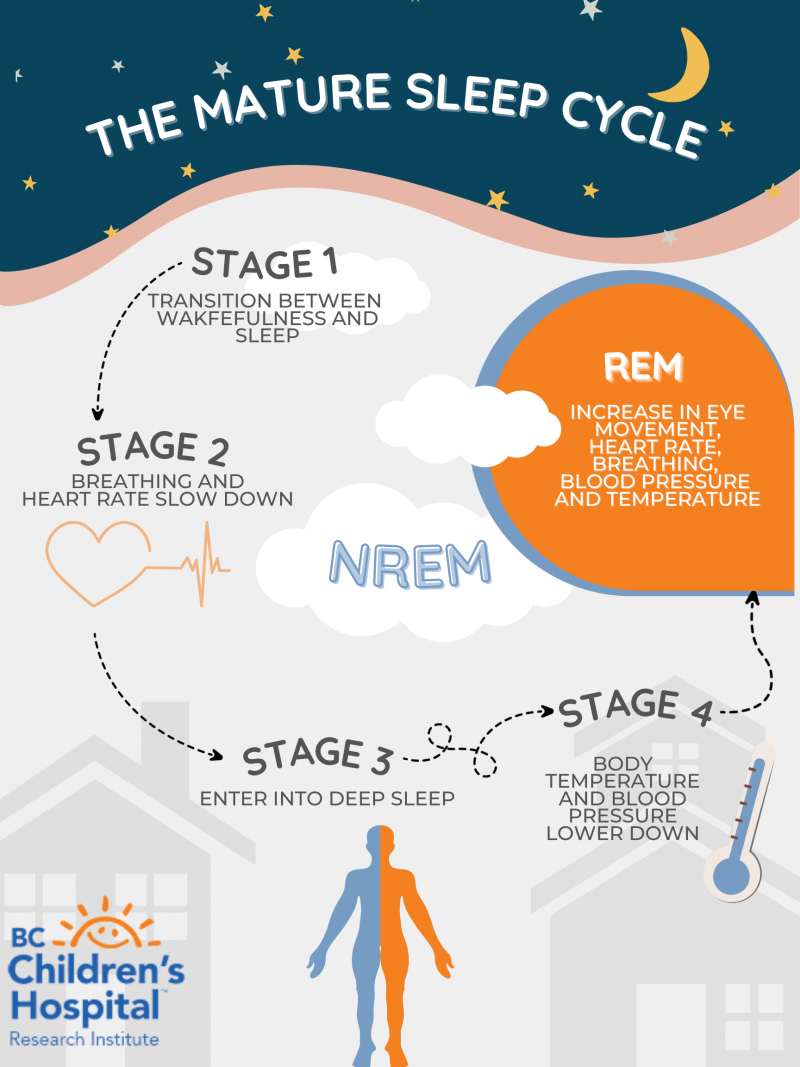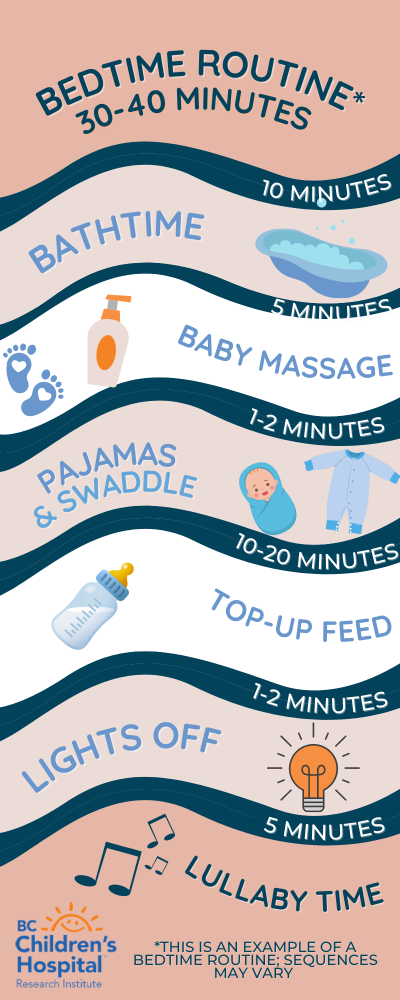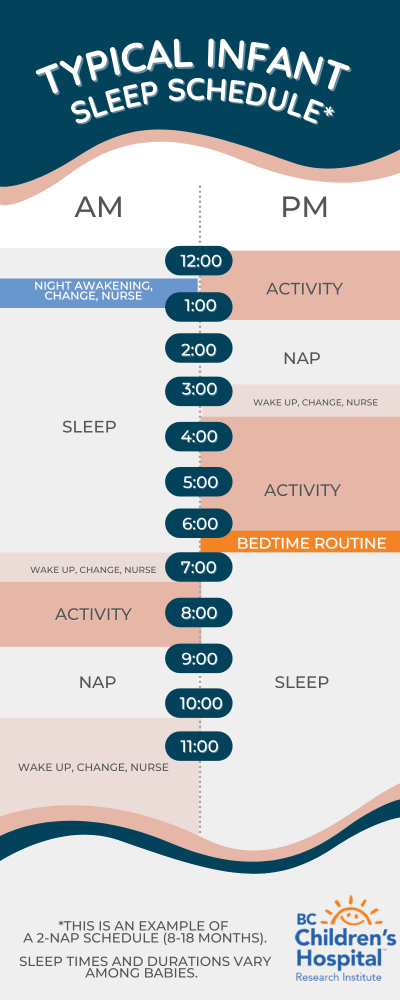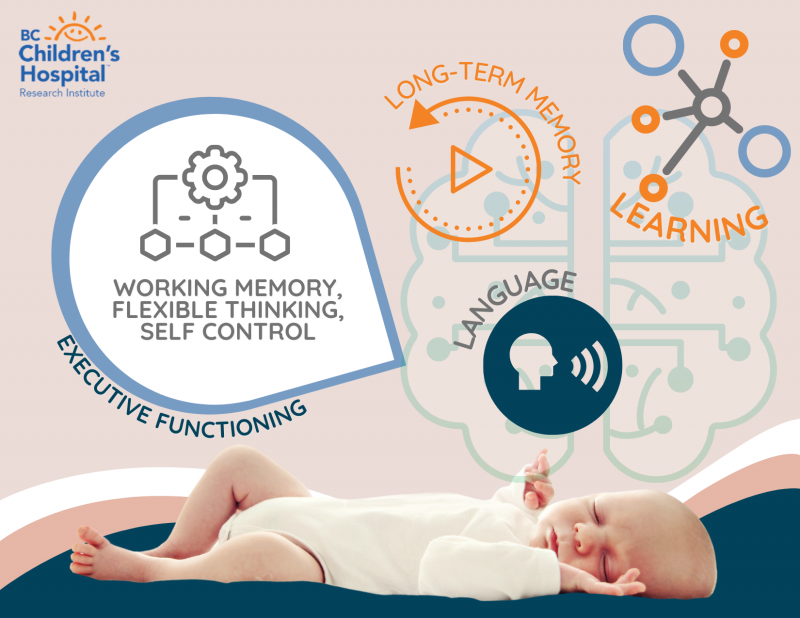Infants (4 – 18 months)
As infants grow, their sleep is more structured, but is still spread out over the course of the day. How does sleep change through the first year?
Sleep Architecture
At this stage, infants are transitioning out of active-quiet sleep and are developing a more mature sleep cycle. By around 6 months of age, infants begin to display the first forms of REM (rapid eye movement) and NREM (non-rapid eye movement) sleep, which together make up the five stages of the mature adult sleep cycle. At this stage, infants usually also display periods of semi-wakefulness, after which they usually fall asleep. The development of the sleep cycle usually continues over the course of early childhood, and fully matures at about 5 years of age. Sleep in infants is usually still taking place during the day but is being consolidated more towards sleeping at night.
Click on the graphic below to view the enlarged image.
Sleep Environment
At this age, infants are already becoming accustomed to the day night cycle, and so maintaining light cues are important for healthy sleep development. Recent research is also suggesting that it is beneficial for infants to sleep in separate rooms from their parents. At this stage it is also beneficial to help entrain the sleep cycle behaviourally, by developing a 30–40-minute bedtime routine for the child by around 6 months of age. This will be helpful in reducing bedtime resistance and improving sleep quality for the child. Of particular importance during the bedtime routine is to use the bedtime routine to make the child drowsy, but to make sure they only fall asleep once you have placed them in their bed or crib, so that they fall asleep independently.
It is also important for the child to fall asleep in a place they will recognize during periods of semi-wakefulness. This is another reason why it is critically important that a child be placed in their crib or bed during a bedtime routine and transition from drowsy to being asleep independently. If they do not recognize their surroundings, it may cause them to wake up when they otherwise would have simply fallen back asleep. This will also help reduce bedtime resistance and improve sleep quality.
Click on the graphic below to view the enlarged image.
Sleep Behaviour
By the time an infant is displaying REM and NREM sleep, they are sleeping on average about 14-15 hours per day. This usually consists of two night-time bouts of sleep divided by a feeding, as well as one to two naps per day. At this age, some infants begin to display separation anxiety when it comes to sleep, which can be alleviated using a bedtime routine, although it is critically important that the child transitions from drowsy to being asleep on their own.
Sleep at this stage is becoming more regulated but will not resemble adult sleep until roughly 5 years of age.
Click on the graphic below to view the enlarged image.
Role of Sleep in Development
There are several developmental changes happening during sleep at this stage of a child’s life. Research suggests that much of the electrical changes we see in the brain during infancy are related to the development of various neural networks in the brain required for information processing. Other research suggests that the changes in the brain during sleep at this stage represent the development of various cognitive tasks such as learning, memory, language, and executive functioning. From a neurological perspective, many of the brain’s basic higher-level functions show changes in development during sleep at this age. The research also suggests that sleep plays a critical role in organizing these changes, which can have a hand in dictating development later in a child’s life.
Infancy is also a critical time for developing a more mature circadian rhythm as well as starting to consolidate sleep at night. This will lead into the child eventually sleeping exclusively at night and in one bout of sleep (monophasic sleep) once they reach 5 years of age. Improper sleep during infancy can also be predictive of sleep problems later during development, including during childhood and adolescence. These sleep problems later in development can lead to issues in cognitive, emotional, and psychological development, as well as lower academic performance.
The focus of parents at this stage should be making sure that their child gets enough sleep, and that the child is starting to learn to fall asleep independently on a more regular schedule.
Click on the graphic below to view the enlarged image.
Resources
If you think your infant is displaying abnormal sleep, please consult the following resources.
Better Nights Better Days is a sleep therapy program designed for kids between the ages of 1-10 and focuses on remedies for sleep issues and general insomnia. If your child is having issues falling asleep and staying asleep, click on the button below to visit their website.
There’s a Monster in My Closet is a website that offers sleep education programs for kids over the first five years of life. For more information on better approaches to sleep and proper sleep hygiene, click on the button below to visit their website.



